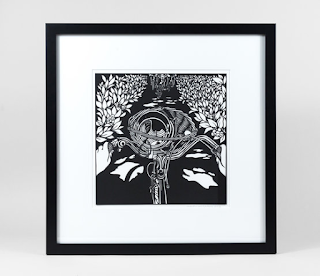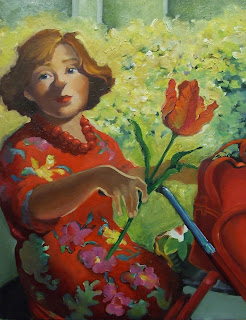By
Alec Clayton
Published in the Weekly
Volcano, Aug. 24, 2017
 |
| Wait Until Dark poster designed by James Stowe, courtesy Lakewood Playhouse |
Lakewood
Playhouse opens its 2017-2018 season with the classic thriller Wait Until Dark,
one of the most suspenseful plays ever mounted on stage. The play by Frederick Knott was first performed on Broadway
in 1966. A film version starring
Audrey Hepburn and Alan Arkan was released the following year, and it has been
revised on Broadway and performed in community theaters repeatedly ever since.
Lakewood Playhouse calls it a cat and mouse game. Susy
Hendricks (Deya Ozburn) is a blind, but has learned to get along quite well
without eyesight. She and her husband, Sam (Ben Stahl, recently seen as the monster in New Muses Theatre’s
Frankenstein) are threatened by a trio of potential killers; but in the dark
Susy has the advantage on them.
“The
play is a tight, one-room thriller with a detailed story and complicated
mechanics, and working on it really keeps you on your toes,” says director
James Venturini. “And the ending, when played truthfully, is extremely
harrowing.”
Venturini
says that he was attracted to the script because the characters are complex and
interesting, and not stereotypes or caricatures. “It's not a mystery, but more
of a suspense thriller, so you’re not pursuing a solution, but a resolution,
and it has some interesting twists.” He says he saw the film when it first came
out and again about two years ago, and likes the play better.
Ozburn,
who does the lion’s share of the heavy lifting in this drama says her character,
Susy, lives a life “not quite as posh as Laura Petrie, but not far from the
mark, in essence,” even though she is totally blind. “It’s a very psychological
thriller,” Ozburn says. “For one of the men: it’s a game…like a cat playing
with its food before he kills and eats it. The other two are more grifter-style
in approaching the con, but all have at her in their own way, and though for
great parts of time she could easily escape and get out of there…she doesn’t.
She stays, and defends her home and person, finding out what her true potential
really is…it’s a whole ‘hero’s journey’ in a basement, really.” And she
triumphantly adds, “And written for a woman. In 1966. How great is that?”
Jed
Slaughter plays Mike, one of the trio of bad guys. He says, “One of the things
that appealed to me was that it would allow me to play a different sort of
character from my most common archetypes: the nice guy and the comically
misogynistic jerk. While my character, Mike, is generally the ‘nice guy’ of the
trio of criminals, he's still ultimately a con artist trying to swindle a blind
lady. When I read the script leading up to auditions, Mike was definitely the
character who most appealed to me. He gets a chance to really evolve over the
course of the show in how he views and interacts with the other characters that
surround him. It's also great fun to convey two different intentions
simultaneously, as we're often voicing one thing while being free to completely
contradict ourselves visually, taking advantage of Susy's blindness.”
Rounding
out the cast will be Mari Dowd, Kerry Bringman, Lakewood Playhouse artistic director
John Munn, and Travis Martinez.
Ozburn
sums up her assessment of her character, Susy, by saying, “It is not her lack
of sight which dooms her, and makes her a stereotypical victim. It is her
intellect and sense of fight that we are watching, and rooting for. Yes, she is
battling three men who are constantly at a physical advantage, but they mistake
the situation and unmask their own folly by underestimating someone’s ability
to thrive and survive with any kind of limitation.”
Wait
Until Dark comes with a parental advisory. It contains scenes of psychological
horror and intense action. There will be special showings September 14 (Pay
What You Can Night) and September 21 (“Pay What You Can” Actor’s
Benefit).
Wait
Until Dark, 8 p.m., Friday-Saturday, 2 p.m., Sunday, Sept. 8-Oct. 8, Lakewood
Playhouse, 5729 Lakewood Towne Center Blvd. Lakewood, $20-$26, 253.588.0042, lakewoodplayhouse.org









